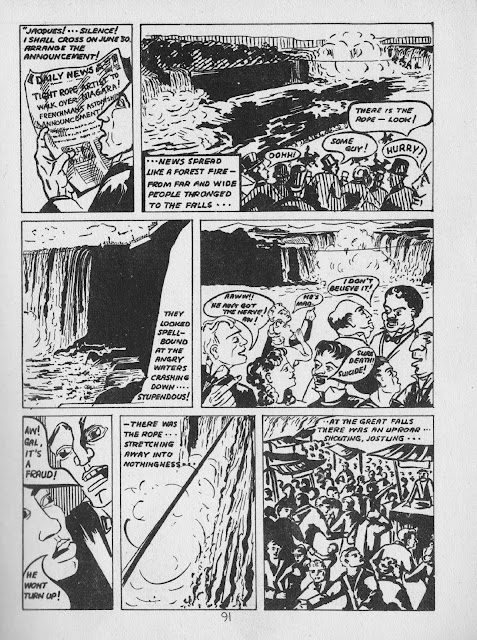The first thing to state is that what follows are my original scans and notes. References to these two annuals usually comprises of "Robert Edwards Ltd"/"some rather crude art" and "1950 +/-". If you see any of the following scanned pages or information on other blogs/sites without a credit to me, well, that's plagiarism.
Now the next thing to mention are the covers which are card making them paperbacks -some sources have stated "hardback".
Robert Edwards Ltd: despite a very long search I cannot find any information on this publisher and certainly no other books published by him/them. This is thrown in with the fact that all we have is "Printed and published by Robert Edwards (London) Ltd, London, N.W. 1" and that raises suspicions.
Material published in the books comes from the comic packagers Bayly and Souster who put material together for the large number of Independent publishers trying their hands at comics in the early 1950s (there were a LOT). Dick Hercules and Captain Vigour appeared in their own Cartoon Art Production (CAP) comics and Hal Starr by Sydney Jordan appeared in Strange Worlds published by Man's World/Atlas.

Let's look at the dubious world of comics angle first. Someone pulls together some comics and adds filler pages of quite crude art that, honestly, no real publisher would have used or paid for at the time. Were the amateur strips by whoever published the books or even a family member or, perhaps, someone who wanted to be in comics? The truth is that we will never know unless anyone involved comes forward but at 2/- 6d (two shillings and 6 pennies) these were not cheap. Were these rip-off books? Hence no address (very unusual at that time) and, perhaps a made up name? Oh, and adding "Ltd" to your publishing name is not unheard of (even into the 1980s and we should all know who I mean).
Above: contents of Adventure Comic Annual
______________________________________
The alternative is that someone, Robert Edwards, saw the boom in comics and thought they might try their hand at it -annuals appeared just before Christmas each year so having two on sale might show a profit. Getting some cheap art and adding it to licensed(?) strips or remainder comics would be cheap if you were looking for a profit. Legally, even back then, you would be sued for ripping off another publisher -as we do not know the deal CAP had with Bayly-Souster it is possible they owned the rights and could sell them around.

Next the ever elusive date of these books. "1950 +/-" is the date everyone seems to give but there are major clues that I spotted straight away -as should anyone owning the books. The first is that the Rob Roy strip has almost every page signed by C (or G) Vernon Stokes and most have the date "1953" or "53" on them. Next is the fact that Hal Starr first appeared in 1954, Dick Hercules 1952-1954 and Captain Vigour, likewise, 1952-1954. If we look at those as guidelines then we can narrow these annuals as being 1954. Two titles had ceased publishing and Hal Starr had begun that year.
All other strips, the more professional and amateur, are all unsigned apart from C or G. Vernon Stokes. I can find no comic artist by that name so if anyone does know of him let me know please. G. Vernon Stokes was a well known animal artist (hounds a speciality) but he was born in 1873 and died in 1954...I think we can kind of rule him out.
Let's take a look at a few of the pages from these books -firstly the Adventure Comic Annual.
Above: I am guessing by the style that this comes from the Captain Vigour comic which makes sense as it seems to have been included complete.
Above and below: uncredited but just within comic standards for the time.
Below: definitely not within the standards or even the 1940s comics but again uncredited. Some of the strips are presented as "based on real events"
Below: NOT Kangy the kangaroo kid but Kangi the Wolf Boy
Below: I love that title! There is some nice marine art here but human anatomy is poor but a fun little yarn.
Below: the same artist as for a lot of the more amateur strips drew another "real life! account full of what you might expect from post war Britain.
Below: Sydney Jordan's Hal Starr
Below: this was the Hal Starr back-up strip so it seems the comics were printed as a whole.
Next we come to the Wonder Comic Annual
Above: Now this is very cheeky. Firstly, no Mexican character appears in the book and secondly, as soon as I saw this I realised the character was from Amalgamated Press. I had first thought Knockout and checked my annuals but, no. I have a few hundred annuals and so I left it! If anyone can identify him let me know.
Above the contents page
Below: Rob Roy o' the Glen by C/G Vernon Stokes
The credit and date in close up
Below: uncredited
Below: Sydney Jordan work?
Below: I say NOTHING about the title! Uncredited and I did think Mick Anglo at one point
Below: Dick Hercules
Below: another "based on fact" story
Below: in case you were wondering about that pirate themed cover....
Which brings us to another based on fact tale....
Some might ask why I bother showing the "lesser quality" strip work. Well, it forms a large part of the annuals and who ever the artist was he deserves some credit because at least he tried and, perhaps, had hopes of getting on in comics. We will never know. THAT to me is the sad thing about these early comics. So much is unknown or forgotten or hidden away for shady reasons but every creator deserves to be credited.
Anyway, those are my comments and thoughts on the enigmatic Robert Edwards Annuals. If anyone knows more then PLEASE get in touch because this is comics history that should not be forgotten.
(c)2020 Terry Hooper-Scharf






































